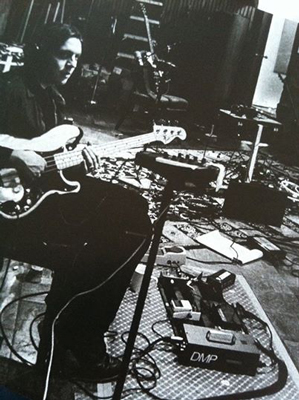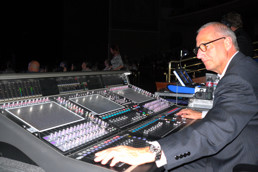
Artist Spotlight: Arctic Monkeys
BAE Gear: 1073DMP, 10DC, 1073MP
Arctic Monkeys are an English indie rock band formed in 2002 in High Green, a suburb of Sheffield. The band consists of Alex Turner (lead vocals, rhythm guitar), Jamie Cook (lead guitar, backing vocals), Nick O'Malley (bass, backing vocals), and Matt Helders (drums, backing vocals). Former band member Andy Nicholson (bass guitar, backing vocals) left the band in 2006 shortly after its debut album was released.
The band has released five studio albums: Whatever People Say I Am, That's What I'm Not (2006), Favourite Worst Nightmare (2007), Humbug (2009), Suck It and See (2011) and AM (2013), as well as one live album, At the Apollo (2008).
The band's debut album is the fastest-selling debut album in British music history, surpassing Elastica's self-titled album. The band has won seven Brit Awards—winning both Best British Group and Best British Album three times, and has twice been nominated for Grammy Awards. The band also won the Mercury Prize in 2006 for their debut album, in addition to receiving nominations in 2007 and 2013. The band has headlined at the Glastonbury Festival twice, in 2007 and again in 2013.
Read MoreRenowned guitarist and recording legend Steve Vai has picked British Audio Engineering (BAE) mic-pre's and EQ for his demanding stage and studio needs. After extensive testing and auditioning ten of the top products available today, Vai remarked, "BAE is the clear winner, simply stunning -- kind of magical."
In 1999, BAE carved out a premium niche in the vintage Neve/API market as the first company to remanufacture the 1073 mic-pre/equalizer since its discontinuation by Neve in the 70s. After years of repurposing and racking up mic-pre's and EQ from classic Neve and API consoles, BAE now faithfully recreates new versions using original sources, including Jensen transformers, Carnhill transformers, and Elma gold-plated switches from Switzerland.
To decide on BAE's new 1073, Steve Vai did a comparison with the original, a modern day circuit board replica, and BAE's new unit. "BAE has the smoothest and most responsive EQ I have ever heard," he commented. "It just adds a beautiful air and is clearly superior. I tested the mic-pre's without any EQ and they come back fat, round and warm. The edges aren't too sharp and for the guitar that is so important. You can EQ for days with this BAE gear and it just brings the sound to life. It's like every day is Christmas."
"It's all discrete and completely hand-wired," explains Mark Loughman (pronounced Lofman), who after serving as chief engineer for many years is now CEO and owner of BAE. "The original Neve 1073 mic-pre/EQs are known as the Holy Grail of outboard gear, but manufacturing was discontinued in the 70s. Eventually that supply has dried up, so we have gone to the original component suppliers to continue the legacy."
As the owner of a classic API console for years, Vai is especially critical of modern day mic-pre reproductions based on that standard. "I experimented and changed the op-amps, but until now I could never find anything that retained the integrity of that old API sound. That gear eventually gets old and you have to recap it and it loses some of its juice. The new units on the market today just didn't sound the same. BAE's new 312A mic-pre and DI is leagues ahead, right up there with the integrity of the original. Hand-wired, it's like an art form to make gear that sounds like this.”
BAE Gear: Steve Vai is an avid user of the BAE 1073 and 1028.
Big Chris Flores is a top record producer and sound engineer from the US. He first began his music production career in 1999, and in 2002, he founded Moodswing Records. Rocking BAE Audio in his chain, Chris owns and works from Rehab studio in Van Nuys CA.
As a touring musician turned skilled producer, he has worked with singer–songwriter and record producer Baby Face assisting and engineering, and has achieved producing, mixing, engineering credits for artists such as: En Vouge, Slash, Kenny Loggins, Fergie, K-Ci & JoJo, Layzie Bone, KRS One, C-Bo, Bun B, Trill OG, Lil Zane, Cedric the Entertainer, and Bone Thugs-n-Harmony.
"I've used 1023s for everything from live bass, to electric bass, female vocals, to baritone vocals."
Big Chris Flores
BAE Gear: Part of Big Chris Flores' arsenal includes the BAE 1073, 1023 and the 312A
C.J. Vanston is an American film composer, record producer, songwriter, and keyboardist, based in Hollywood, California. He has contributed to numerous albums, including those by Prince, 'NSync, Barbra Streisand, Ringo Starr, Celine Dion, Bob Seger, Richard Marx, Tina Turner, Joe Cocker, Anna Vissi, Yellowcard, Spinal Tap, Harry Shearer, Steve Lukather, Dennis DeYoung, and Toto.
CJ Vanston was initially doing jingles in Chicago where he became well known in that industry segment and rose to become trhe first call guy in the trade. He became so busy doing jingles that at one point he was doing six sessions a day and practically living in the studio.
At the same time, he began to realize that the was not using his talent for what it was meant for, which was making records. He had a burning desire to make records and when his mentor "Rick Marks" told him that his son Richard Marks was making a record, he felt that Richard and CJ Vanston should work together.
So, following his advice, CJ Vanston gave up doing jingles and moved to Los Angeles. Everyone thought he was crazy, giving up the vocation that had brought him success and fortune, but he had made up his mind and knew that he was doing the right thing.
The first song that he did with Richard was 'Right Here Waiting' which was actually just the demo was so good that it ended up being used as the record. Within a week of its release, it was on every radio station and soon reached the top of the charts. After this phenomenal hit single, CJ Vanstion started getting multiple requests for assignments and one offer in particular came from Phil Ramone, who wanted to do a record with him. They got along together so well that he ended up as Phil's recording guy for about five to six years.
CJ Vanston then turned his attention to mixing and arranging music for songs. Instead of showing up with a chart, he would show up with a fully prepared music track of how he perceived the song should sound. He would add the bass and keyboard and everything needed by himself. The awe he received improved his confidence.
Though he was not very technical, CJ Vanston had good ears and could instinctively tell what sounded good. He worked with software and recorded with analog gear to get the perfect sound. He often uses the BAE 10DC compressor to monitor with, and has used this to perfect his sound for many artists including Toto. The BAE 10DC is his favorite piece of equipment, he loves the look, the feel, and the sound clarity that the 10DC provides. He can simply set it and forget it. CJ finds the 10DC very reliable and noted that some of his best compositions were made using it. He could set the 10C up in a specific way for mastered sounding results while the band was being tracked.
Everyone CJ recorded loved the way their music sounded when he used the BAE 10DC. CJ Vanston has used the 10DC for overall recording, the bass, the guitar, the cello, background vocals and practically everything.
"10DC’s were just beautiful sounding. Big, fat, round, beautiful…"
C.J. Vanston
BAE Gear: C.J. Vanston's studio includes the BAE 1028, 10DC and the 1073DMP
"With the 1084 I've been able to recreate some very 70's sounds... and it's amazing. It takes me right back..."
-Simon Philips
Drummer extraordinaire turned producer Simon Philips knows a thing or two about what vintage gear sounds like, and has a special appreciation for BAE Audio. “I began my recording career in the early 70s at the age of 16, and I played through a lot of classic consoles of that era around London when they were still new,” he says. As his renown as a session drummer mounted, his knowledge of studio technology also gained notice, ultimately resulting in his first opportunity as a studio engineer on a 1983 session for Mike Oldfield.
“I was co-producing the record, and knowing the ropes around the studio was suddenly told, ‘You’re the engineer now.’” Today Philips owns and operates his own studio, Phantom Recordings, in Sherman Oaks California, where he has recorded his own band Protocol and many other internationally recognized artists. BAE Audio’s 1084 and 1272 modules are an integral part of his signal chain at Phantom Recordings, and the sonic results meet both Philips high standards and those of his clients.
Old Meets New
Philips recent production triumphs are manifested in Protocol’s latest effort, entitled Protocol III, and Bill Rainbird’s Deep Blue: both recorded through Phantom Recordings’ unique vintage16-channel 4-buss mixing desk fully retrofitted with BAE Audio 1084 and 1272 modules. “There are a lot of vintage consoles and they’re beautiful and they sound great, but time has changed them. I can pretty much guarantee they don’t sound the same as they did back then,” Philips notes.
BAE Audio’s faithful recreations of classic British preamplifiers, which include the very same Carnhill input and output transformers used in the originals, were perfect for resuscitating the aging console, “bringing it to life,” as Philips says. “I use it as a tracking board of course with the great input and EQ sections of the 1084,” Philips explains, “and I’ve also been using it as a 16-channel summing board for my ProTools HD sessions by routing the channels into the line inputs of the 1084s and then routing those into the 1272 busses.” For Philips, this method is consistently superior to mixing entirely in the box. “Splitting the mix into stems and incorporating the analog signal path adds something to my mixes that I find very pleasing to the ear.”
Visualizing the Audio
When it comes to micing up a session, Philips has a unique approach to assessing the best setup. “I’m very visual, I see what the session entails – what the line-up is, what the music is like – and I get a mental picture of what it’s going to sound like,” Philips explains. Whether he’s behind the kit or not, he pays special attention to how drums are recorded. “I prefer to use condensers on both overheads and close mics the majority of the time,” he says, “and they go right into the 1084 modules.” Philips loves how the 1084 performs on guitars as well. “When you mic up a 4x12 cabinet you often end up with a lot of muddy low end, so I really appreciate having access to the 1084’s hi-pass filter to control some of that.” Brass and piano are some of the other instruments that Philips says really shine through the 1084s, though he concedes, “everything sounds wonderful through them, really.”
The More That Things Change
Philips has been in the industry long enough to have worked with many iterations of recording technology. “While a lot has changed, the basic signal path is still the same: a microphone, a cable, a preamplifier, a recording device,” Philips says. “With digital recording you can go back and tweak a lot of things after the fact, but you’ve got to get the signal chain right the first time, and that’s why BAE Audio is such a great choice for vintage sound and modern reliability.”
BAE Gear: The revived vintage console at Philips’ Phantom Recordings Sports BAE Audio 1084 and 1272 Modules, and 10DC compressors for a'Classic Sound without the Rust.'
BAE Audio Gives LA Noise Rockers HEALTH A New Urgency on Death Magic
HEALTH Turns to BAE Audio’s Classic 1073 Preamplifier to Capture Far Out Sounds, Directly from Their Guitars’ Massive Effect Chains
For Los Angeles-based band HEALTH, finding a unique sound that grabbed listeners’ attention came naturally. Beginning with their 2007 self-titled debut, they blended elements of noise, rock, and electronica seamlessly in songs that are at once both infectious and deliciously abrasive. But in the six years between 2009’s LP Get Color and their upcoming release Death Magic, the band perceived that the sound of music around them had changed by leaps and bounds. HEALTH has since turned to a new workflow focused on direct guitar recording through BAE Audio 1073 preamplifiers, giving their analog instruments the added punch they need to go toe to toe with HEALTH’s bevy of digital sounds.
“We were hearing how music production had really changed where you’ve got these pop-star songs that are hitting harder than a heavy metal record because of the production,” says HEALTH band member John Famiglietti, “and we’re saying to ourselves, hey, we make heavy music and there’s no reason our stuff shouldn’t be hitting harder than teeny bop music.”
A New Approach
Capturing HEALTH’s musical vision in the studio has always been a challenge for the band. “When we did our first record, we were recording ourselves for free in a place we used to perform downtown called The Smell. But it had this cavernous natural reverb and we had to wait until 4 a.m. because the place next door would be blasting reggaeton until then,” Famiglietti recalls. “Then on our second record we tried to work in a recording studio but had a bad experience.”
It was during their work on the soundtrack for video game Max Payne 3 that they added the BAE Audio 1073 to their collection at their rehearsal and recording space. “We had read a lot of recording magazines so we knew about vintage gear and the sound of the classic 1073, and everyone we talked to was like ‘You should get the BAE, it’s like the original but better’.” The band picked up two BAE Audio 1073s and started recording their analog instruments, including guitars, directly into it, making less and less use of their guitar amplifiers. “It sounded great and it was really convenient,” Famiglietti explains. “Working on the soundtrack was a little frantic and we had to turn things around sometimes overnight, so being able to just plug in and get a great sound right away was huge.” Getting It Right
When it came time to work on their next proper LP, HEALTH was determined to go beyond anything they had done before. “Our attitude for this record was ‘We have to get it right this time’,” Famiglietti says. Excited with the way the 1073 captured analog sources on the Max Payne 3 OST, they continued to use it for all direct signal input on Death Magic, while also making ample use of it for vocals and on drum overheads. “We’ve got a crazy number of pedals on our signal at all times making all kinds of wacky sounds, and the 1073 just gives it all that realness,” Famiglietti says, citing both its crisp clarity and a subtle warmth in the lower midrange. “We know the digital stuff we do is going to be slamming out of the box, and the 1073 allows us to get the analog signals just as punchy and clear.”
With the release of Death Magic on August 7th, HEALTH is getting ready to hit the road in support of an effort they feel is their strongest to date. “Our challenge on this record was updating our sound for the times but doing so in a way that’s true to who we are as a band,” Famiglietti reflects, noting that they could not have succeed to that end without the right tools. “Going direct into the 1073 I’m just getting a better sound than anything I’ve used before,” he adds. “It’s a must.”
Click here for more information on the BAE 1073.
FOH Engineer Lars Brogaard for Rod Stewart: BAE Audio Preamplifiers
During a Three-Week Residency at Caesars Palace, a Concert in Hyde Park and for a Reunion with The Faces, Legendary FOH Engineer Lars Brogaard Turns to BAE Audio for Sonic Depth
With high profile concerts in Las Vegas, Hyde Park and Rio de Janeiro and an album release set for this October, legendary Rod Stewart continues to bring his pitch perfect, A-level performances to both stage and studio. His touring entourage — with longtime right hand man and FOH engineer Lars Brogaard at the controls — recently completed a three-week residency at Caesars Palace, a Faces reunion benefit show, and are now looking forward to a performance in London's Hyde Park before 70,000 fans next week. As Stewart continues to bedazzle audiences with his raspy, emotionally nuanced vocals, Brogaard is relentless in achieving the best possible sound. To accurately capture a natural sound for drums, bass and vocals, he recently turned to BAE Audio.
Brogaard, who has been looking after Rod Stewart's sound for 30 years, began tinkering with gear when he was just 16 years old living in Denmark in the mid-seventies: "I ended up running the sound for several bands because I wasn't good enough to play myself," he recalls. Shortly thereafter, he moved to England and got his first big break as monitor engineer on ABBA's world tour in 1979, and then handling FOH mixing for artists like the Beach Boys, Diana Ross, Lionel Richie, ABC and many others. "I started in this business doing sound, and I am always trying to make the sound better. This is something that I have always cared deeply about," he explains.
At the recommendation of Stewart's bass player Conrad Korsch, Brogaard tried using BAE Audio 312 preamplifiers on the drum kit during Stewart's residency at Caesars Palace last spring. He was astonished at the sound: "The acoustics at The Colosseum are exceptional to begin with," he recalls. "But when we tried the BAE Audio 312s on the drum kit, we were able to hear a massive increase in both depth and tone. We could hear much more detail in the natural sound of the wood coming off of the drums — the difference was truly amazing."
The experiment on the drums made Brogaard curious about what he could achieve by putting a BAE Audio 1073MPF preamplifier on Rod's vocal, and the resulting sound was hand in glove. "It is all about the depth, and the unit was able to capture the depth in Rod's voice with a certain natural sheen that I hadn't heard before." Brogaard wasted no time integrating the BAE unit into Rod's vocal chain, bypassing the preamplifiers in the FOH mixing console. Once all of these changes were made, there was unanimous approval: "Everyone on the tech team thought there was a noticeable difference and that it sounded exceptional," he says.

A Vintage Preamp for a Singer's Singer
Brogaard is very particular about equipment choice, especially when it comes to Stewart's vocal: "Rod is pitch perfect, a singer's singer," he says. "Even though his public image often entails girls, fast cars and soccer, he is really very musical and knows exactly what he wants to hear. It is especially moving to hear the raspiness of his voice on the ballads during one of his live shows — it is a true gift, especially considering he's 70!"
Currently, Brogaard is using (8) channels of BAE Audio 312s on the drums, a 1073DMP on the bass and a 1073MPF on Stewart's vocals. Brogaard keeps the preamps nearby the monitoring console to minimize copper cable runs, thus avoiding potential signal degradation. The new preamplifier rig — which consists of an (8) space 3U 500 series rack unit, a 1U 1073MPF and a 1073DMP — is being used for all of Stewarts performances, including the reunion with Faces, the concert in London's Hyde Park next week, and a gig at Rock In Rio scheduled for the end of this month.
Brogaard, meanwhile, is always refining Rod Stewart's sound and hasn't looked back: "I never got into this business to make money — I got into it because I wanted to be a sound engineer." After the new album is released in October, Stewart, who is touring with a 13-piece orchestra, will once again have a residency at Caesars Palace in the spring.



